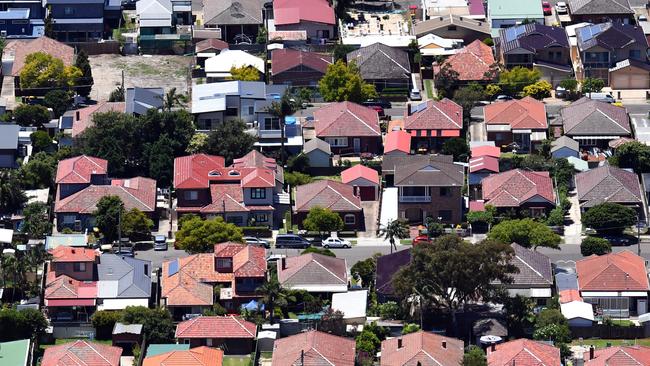Aussies no better off since GFC: household incomes stagnant for past decade
Living standards have stagnated since the global financial crisis, finda a major national survey.

Living standards have stagnated since the global financial crisis, according to a major national survey that finds poverty is on the rise and compulsory superannuation has failed to reduce dependence on the age pension.
In figures likely to reignite debate on the impact of bracket creep, the typical household’s income, after tax, dropped $500 to just more than $80,000 in 2017, compared with a year earlier.
MORE: Gig economy fears ‘not warranted’ | Commute now longer than ever | Kids follow parents into drugs | Young Aussies ‘delaying adulthood’ | Women earn more, stress grows | How we work, play since financial crisis
“Over the eight-year period from 2009 to 2017, average household income grew by only $3156, or 3.5 per cent, while the median in 2017 was $542 lower than 2009,” the report, which has tracked the circumstances of more than 17,500 Australians since 2001, finds.
The share of households in relative poverty — living on less than half the median income — rose to 10.4 per cent, according to analysis released today by the Melbourne Institute that will add to the controversy about the adequacy of Newstart, the government’s jobless payment.
Median annual income, which includes welfare payments, has dropped $100 since the Coalition was elected in 2013, highlighting the political challenge of the Coalition’s “get a go if you have a go” election pledge.
Professor Roger Wilkins, who analysed the latest results, looked on the bright side of sluggish income growth. “We had booming incomes that were driven by a temporary rise in commodity prices, and we’ve been able to keep it at that level since,” he said, referring to the resource boom in which median income rose $3000 a year between 2003 and 2009.
The figures follow rosier data from the Australian Bureau of Statistics, released earlier this month, that revealed average household wealth had surged past $1 million last year — up 37 per cent from a decade earlier — while median household income rose 9 per cent in eight years, after accounting for inflation.
Stagnant median incomes have blighted advanced countries in recent years. The median household income in the US in 2016, $US60,309, was lower than it was in 1999, according to the US census. In Britain, the median household income shrank between 2005 and 2014. It increased 1.4 per cent last year to £29,400.
The new Household, Income and Labour Dynamics survey — known as HILDA — also found that welfare reliance among the over-65s had changed little in a decade.
Professor Wilkins said that highlighted the ineffectiveness of compulsory superannuation.
About 30 per cent of households relied on the age pension for more than 90 per cent of their household income in 2017, a little higher than in 2009. “Whatever objective you might have for superannuation, it’s hard to find a reasonable one that it’s succeeded in achieving,” Professor Wilkins said, adding that he “couldn’t conceive” why the government would lift the superannuation guarantee to 12 per cent as legislated.
“It’s completely dishonest to say the increase won’t be at expense of people’s wages,” he said, taking a swipe at claims that higher compulsory super contributions came on top of wages. Over half of householders aged over 65 relied on welfare for more than half their income.
For the first time in the 14-year history of the survey, the ACT lost its position as the jurisdiction with the highest median income, pipped by the Northern Territory, where it rose to $67,061.
In the ACT, median income dropped 11 per cent between 2013 and 2017 to $66,230. Among the five biggest state capitals, the median income in Sydney was the second-lowest (ahead of Adelaide), rising 1.6 per cent in four years to $48,569. Meanwhile, Perth’s median income dropped the most, 5.2 per cent, but the West Australian capital remained the highest-earning city.
“Our other measures of financial stress have been trending down, even though incomes haven’t been rising,” Professor Wilkins said, suggesting households might have “made a psychological adjustment” or started “managing their finances better”.
“Perhaps people were expecting their income to go up next year, and now they’ve gotten used to the fact they aren’t,’’ he said.
Also for the first time, the survey examined how households’ incomes in 2017 compared with those of their parents in 2001, the first year of the survey.
Teenagers born into the households in the bottom fifth of the income distribution have a 38 per cent chance of still being there in their early 30s, while those born in the top fifth have a 31 per cent chance of remaining in the same income class.
“There is some evidence that short- to medium-term income mobility has reduced slightly this century,” the report says. “Mothers tend to be more important than fathers in determining their kids’ outcomes,” Professor Wilkins said.
The share of households living in absolute poverty, on less than $18,500 a year in 2017 dollars, has been about 4 per cent since 2012. “Long-term people on Newstart are unlikely to get their heads above that line at current payment rates,” Professor Wilkins said, wading into a debate over the adequacy of a payment that hasn’t increased in real terms since 1994.
On superannuation, the report says “the continued maturation of the superannuation system since 2009 might have been expected to further reduce reliance on income support, but there has been relatively little net change since 2009”.




To join the conversation, please log in. Don't have an account? Register
Join the conversation, you are commenting as Logout